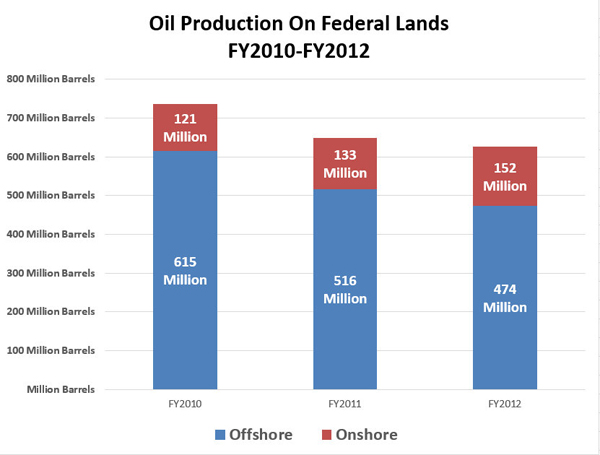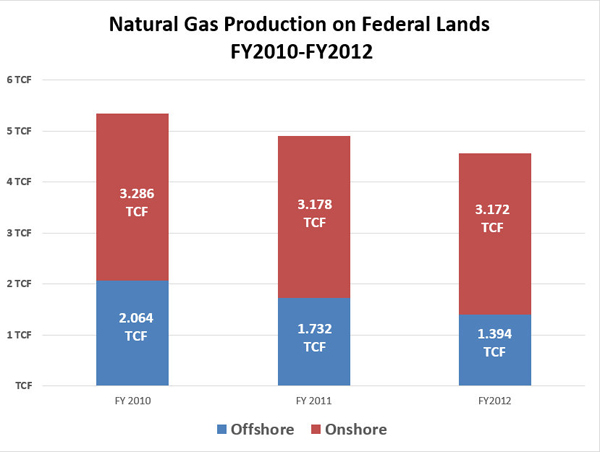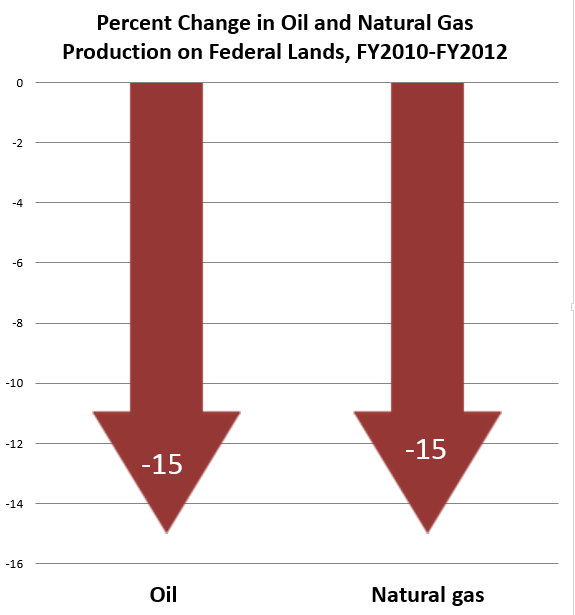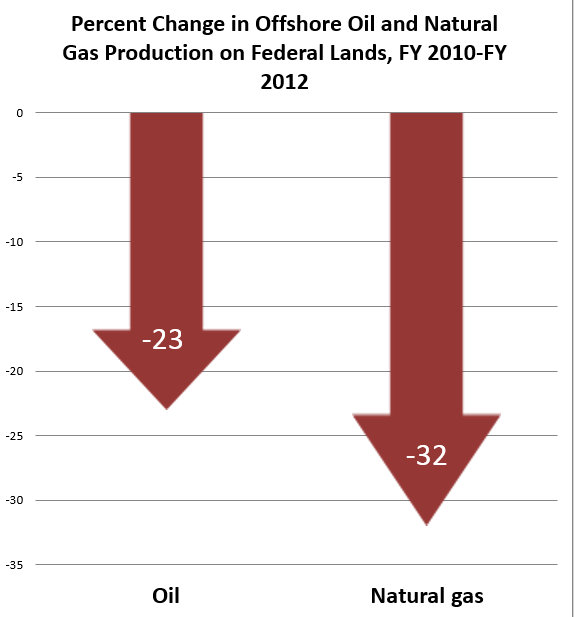“I’m proud of the fact that under my administration, oil production is higher than it has been in a decade or more. President Obama, February 20, 2013
When President Obama claims responsibility for the increase in oil and natural gas production in the United States, it is important to know that he is referencing the energy miracle that is occurring on private and state lands, where his Administration has little or no say over what happens. In fact, the United States is the largest natural gas producer in the world, and last year, production of oil increased at the fastest annual rate since Abraham Lincoln ran for the U.S. Senate. From those lands that the President oversees, however, oil and natural gas production fell again last year.
The Office of Natural Resources Revenue of the Department of Interior (ONRR) just released its sales volume data for fiscal year 2012 with the result that oil and natural gas production on federal lands dropped again in FY 2012.[i] Natural gas production on federal lands continues to fall and oil production on federal lands fell in both fiscal years 2011 and in 2012 ending two years of increase. Specifically:
- Crude oil production on federal lands is 4 percent lower in fiscal year 2012 than in fiscal year 2011, (a smaller percentage than its reduction in fiscal year 2011 compared to fiscal year 2010 levels), with the total percentage reduction over the 2 years at 15 percent.
- Offshore oil production in federal waters is 8 percent lower in fiscal year 2012 compared to fiscal year 2011 with the total percentage reduction over the past 2 years at 23 percent.
- Natural gas production on federal lands is the lowest in the 11 years that data is available and is 7 percent lower in fiscal year 2012 than in fiscal year 2011 with a total percentage reduction over the past 2 years of 15 percent.
- Offshore natural gas production in federal waters is 20 percent lower in fiscal year 2012 compared to fiscal year 2011 levels with a total percentage reduction over the past 2 years of 32 percent.
Oil and Natural Gas Production on Federal Lands
Crude oil production on federal lands decreased 15 percent over the past 2 years from 736 million barrels in fiscal year 2010 to 626 million barrels in fiscal year 2012. Production of crude oil on federal lands is dominated by offshore production, which fell by 23 percent in fiscal year 2012 from fiscal year 2010 levels, mostly notably due to government actions taken following the oil spill in the Gulf of Mexico in 2010. These actions include a moratorium on offshore drilling by the Obama Administration, followed by a permit moratorium, and withdrawal of President Bush’s 2010-2015 offshore lease plan, which would have opened additional areas to oil and gas production. These areas were made available when President Bush lifted the executive drilling moratorium and Speaker Pelosi and Majority Leader Harry Reid passed legislation lifting a 27 year old appropriations ban on such drilling in 2008. It was not until late in 2012 that the Obama administration released its draft 2012-2017 offshore lease plan that reduced the number of lease sale opportunities from prior plans and that removed areas that the Bush administration had made available to drilling (e.g. off the coasts of the Atlantic and Pacific oceans).
Source: Department of Interior, Office of Natural Resources Revenue, http://statistics.onrr.gov/
Natural gas production on federal lands decreased every year since fiscal year 2003, the earliest fiscal year data available. In fiscal year 2012, natural gas production on federal lands was 4,566 billion cubic feet, 15 percent less than in fiscal year 2010 when it totaled 5.35 billion cubic feet. Offshore natural gas production volumes have been on a consistent downward trend for the last 11 years, and are 32 percent less in fiscal year 2012 than in fiscal year 2010.
Source: Department of Interior, Office of Natural Resources Revenue, http://statistics.onrr.gov/
Source: Department of Interior, Office of Natural Resources Revenue, http://statistics.onrr.gov/
Source: Department of Interior, Office of Natural Resources Revenue, http://statistics.onrr.gov/
Conclusion
The big picture is clear that government policies undertaken by the Obama Administration have produced a significant decline in offshore oil production on federal lands over the past 2 years. If it were not for hydraulic fracturing and horizontal drilling on private and state lands where oil and gas drilling regulation performed by the states is much more efficient than that on federal lands, the United States would not be increasing its domestic oil and natural gas production. Americans can only wonder how much more oil we could have produced if federal policies did not get into the way and how much lower gasoline prices might be if positive actions were taken 4 years ago.







